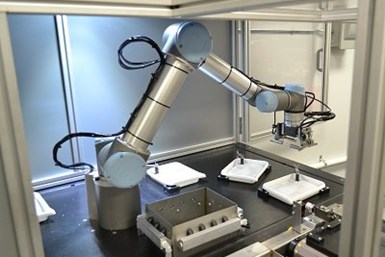Automate Your Brush Plating Operation
Derek Kilgore from Sifco ASC says the brush plating operation can be mechanized, semi-automated or even fully automated.
Q: Can I automate my brush plating operation?

A: The short answer is yes. The brush plating operation can be mechanized, semi-automated or even fully automated. But first you have to ask yourself a few additional questions with your application in mind. A major consideration is practicality – does it make sense to automate your application? Can it be done? Should it be done? Typical reasons for automating a brush plating application include improving quality and consistency, increasing operator safety and improving process throughput.
Through the mechanization of the process, the operator’s direct contact with tooling and chemicals is significantly reduced. Instead, a computer program – which can be configured by the operator – controls the volts, amps, polarity and ampere hours required for the specific application, including preparatory and plating steps.
In practice, this removes the potential for human error and variability from the process, making the operation more reliable and consistent. By accurately controlling the level of deposits with little operator involvement, results are more consistent, thereby driving greater levels of quality for every operation. With the introduction of data logging to the process, automated selective plating also provides full component and process traceability through constant system data monitoring.
Alongside the improved operation results brought about by automation, operator safety is also elevated. Operator safety not only includes removing the operator from the chemicals but also improves operator ergonomics. Reducing risk to the operator by removing them from repetitive tasks and ergonomically unfavorable positions increases the capacity of skilled workers to focus on other business areas. In turn, mechanical systems are able to replicate the application process identically every time, ensuring high levels of consistency without the need for operator intervention.
As well as improving working conditions and safety for operators, automation also leads to greater levels of efficiency and profitability. Mechanized setups allow for operations to run smoothly and consistently until completion, making for greater levels of productivity and the potential for reduced lead times.
Looking more closely at the operation itself, an automated approach also opens up opportunities for improving process throughput. Robotic equipment, which is capable of working around the clock until the completion of a particular application, also utilizes chemicals more efficiently, using only the volumes required at each stage of the selective plating process — effectively removing bottlenecks and increasing throughput.
Generally, good candidates for automation will have most or all of the following characteristics:
- Relatively simple shape (ID, OD, flat).
- Low to medium volume of parts.
- Not too many different part configurations.
- Low deposit thickness.
Once it is determined that the part is suitable for automation, then it’s a question of evaluating the current state and then understanding what the future state needs to look like. There is a significant amount of information gathering and conceptualization that needs to be done to determine options for automation.
So, in this time when industry is seeing the benefits of automating traditionally labor-intensive processes, selective plating can now be considered a state-of-the-art solution that can be semi-automated or fully automated for specific applications.
Derek Kilgore is a mechanical design and project engineer at Sifco ASC. Visit sifcoasc.com
Related Content
Automated Electroplating Systems
Simultaneous engineering reduces energy and resource consumption.
Read MoreGlass Bead Blasting as Plating Pretreatment
What are the best practices for using blasting in preparation for plating? Angelo Magrone of Bales Metal Surface Solutions discusses the ins and outs of glass bead blasting.
Read MoreAn Overview of Electroless Nickel Plating
By definition, electroless plating is metal deposition by a controlled chemical reaction.
Read MoreHow to Choose Between Sulfate and Chloride-Based Trivalent Chromium
There are several factors to consider when choosing between sulfate and chloride-based baths for trivalent chromium plating. Mark Schario of Columbia Chemical discusses the differences and what platers should keep in mind when evaluating options.
Read MoreRead Next
The 2024 Ford Mustang: All the Colors Available
Although Chevrolet has announced the end of the Camaro and Dodge is offering “Last Call” editions of the Charger and Challenger, the Ford Mustang is launching to its seventh generation.
Read MoreEpisode 42: An Interview with Robin Deal, Hubbard-Hall
Hubbard-Hall wastewater treatment specialist Robin Deal discusses the latest trends in wastewater management.
Read MorePowder Coating 4.0: Smarter, Faster, More Efficient and Connected
New tools reduce cost and waste, lower manufacturing footprint of powder coating operations.
Read More

























